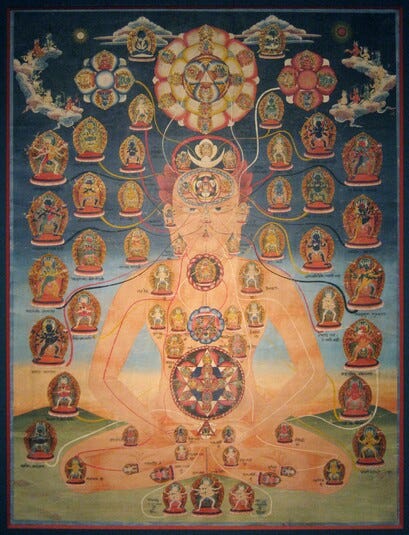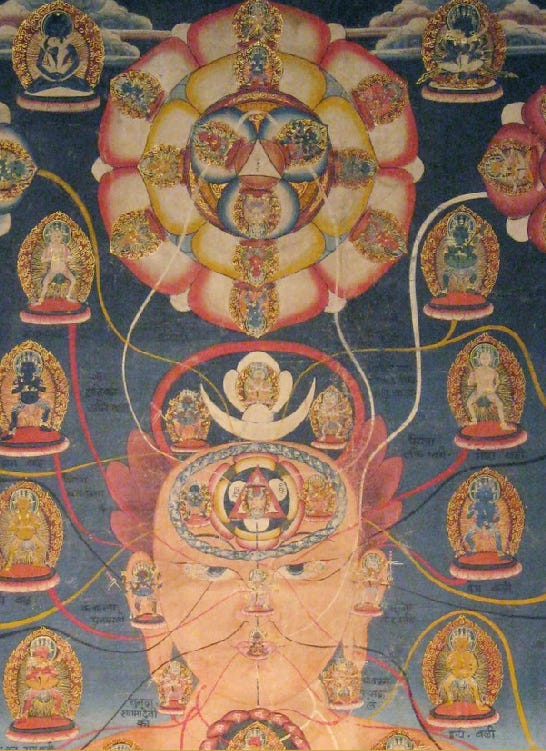
Translation
The subtle body-mandala will be explained by first giving a brief overview of the mandala in general and then explaining the body mandala in detail.
I. Mandala
First, the mandala in general is explained by first explaining the meaning of the term mandala and then what are the different types of mandala.
1. Meaning of the term Mandala
Some Tibetan scholars explain the meaning of the Tibetan term dkyil-'khor (mandala) as dkyil [the centre] referring to the chief deity and 'khor [the circle] referring to its retinue. Some say that dkyil (the centre) refers to the deities and 'khor (the circle) refers to the shrine or dwelling place of the deities (vimāna). Although these are different explanations of the meaning of the Tibetan term dkyil-'khor (mandala), here the Sanskrit term mandala can be understood as. The letter 'ma' of the Sanskrit term mandala refers to the Sanskrit word manupati [Maṇḍa?!], which means essence. The letter 'la' corresponds to the Sanskrit word lalita, which means to enjoy or to grasp. So when the essence, the wisdom of great bliss is received or taken, it is called a mandala. This is the meaning of mandala according to the following verse from the Root tantra.
དཀྱིལ་ནི་སྙིང་པོ་ཞེས་བྱ་སྟེ། །བྱང་ཆུབ་སེམས་ནི་བདེ་ཆེན་པོ། །ལེན་པར་བྱེད་པས་དཀྱིལ་འཁོར་ཉིད། །འདུས་པ་དཀྱིལ་འཁོར་ཉིད་དུ་བརྗོད། [Skt. maṇḍalaṃ sāramityuktaṃ....maṇḍalaṃ mīlanaṃ matam
The dkyil (mandala) is called the essence. When the essence is extracted the bodhicitta, which is the great bliss, and there is union. It is called mandala.
According to the Samputta, the word 'khor (the circle) in dkyil-'khor has the meaning of wheel, for it cuts off the conceptual mind. As stated in the Samputta:
དང་པོ་ཀུན་གྱི་སྙིང་པོ་མཆོག །ལེན་ཅིང་གཅོད་པ་ཉིད་ཀྱི་ཕྱིར། །ལུས་ནི་དཀྱིལ་འཁོར་ཉིད་དུ་བརྗོད།
The body is called the mandala because it extracts the supreme essence and cuts off [the conceptual mind].
So these two meanings don't just apply to the body mandala, mandalas that are made outside with coloured powder and painted on cloths also help to extract the essence, the wisdom of great bliss, so they are also called mandalas.
2. Types of mandalas
Mandalas can be classified into two, three, four, five, six and eight.
(i) First, two classification of mandalas are,
Outer mandala such as made of coloured powder.
Inner three secret mandalas.
(ii) Second, three classification of mandalas are,
According to Buddhagupta:
Deha-maṇḍala: The inborn body-mandala.
Samādhi-maṇḍala: mandala of yogi’s one’s own visualisation.
Image mandala: Such as made from coloured powder, painted cloths and heaps.
According to Samputta (three secret mandala):
Body mandala.
Bhaga mandala.
Bodhicitta mandala.
(iii) Third, four classification of mandalas are,
This classification is based on the four empowerments. According to Virupa's teaching, the mandala is classified in two different ways depending on where and to whom the empowerment is given.
Four types of mandala based on where the empowerment is given
Mandala made of coloured powder.
Mandala of conventional bodhicitta.
Mandala of bhaga.
Mandala of ultimate bodhicitta.
Four types of mandalas based on to whom the empowerment is given
Body channels.
Nadi syllables.
Element amrita.
The essence vital air of wisdom.
(iv) Fourth, five classification of mandalas are,
According to Virupa
Mandala made up from coloured powder.
Mandala of body.
Mandala of bhaga.
Mandala of bodhicitta.
Mandala of vital air.
(v) Fifth, eight classification of mandalas are,
Made from five precious substances.
Made from rice.
Mandala of heaps of grains.
Mandala of painted cloths.
Coloured sand obtained from a cave.
Coloured sand obtained from stone.
Mandala of mind, also known as dhyana mandala or samadhi mandala.
Body mandala, the true mandala.
II. Body Mandala
The body mandala is explained with the following main points: 1. Reasons why the body mandala is more sublime than the outer mandala. 2. The meaning of the term body mandala. 3. Types of body mandala. 4. Synonyms or different names of the body mandala.
1. Reasons why the body mandala is more sublime than the outer mandala
In three respects - cause material, nature and fruit - the body mandala is superior to the outer mandala.
(i) Cause material
The outer mandala requires a physical effort to draw it down according to one's intention with the substance such as coloured powder, copper sulphate, malachite, etc. At the end of the empowerment it is either left in a solitary place or thrown into water, symbolising the transformation into a vajra rainbow body, which is illusory.
However, the moment the body is formed from the sperm and blood of the parents, the four base mandalas and four based mandalas (body channels, channel syllables, amrtia element and wisdom vital air) are spontaneously formed. If you apply this practice in the spiritual path, you will eventually be transformed into a true vajra rainbow body in this lifetime.
(ii) Nature
Whatever external appearances arise, it is all due to the activity of the channels of the body, the vital and refined fluids. When the yogi meditates on the channels of the body, the vital air and the bindu as deities, they also appear in the form of deities. Not only that, all external appearances also appear effortlessly in the form of deities. In the case of the outer mandala, the practitioner won't be able to see the channels of the body, the vital air and the bindu in the form of deities, although he will be able to see the external appearances in the form of deities.
(iii) Fruits
Because it brings the wisdom of the completion phase, the body mandala is more sublime. In accordance with the teaching of Virupa, it is explained here in the following three ascending stages: first, Tummo's yoga of the vital air, second, empty-bliss bindu yoga, and last, the practice of manifesting primordial wisdom.
Tummo’s yoga of breathing:
When you practise Tummo's breathing yoga, it causes problems for practitioners because of the tightness of the knots in the channels, the narrowness of the channels' tubes, and the clogging with sticky dirt. When the practitioner meditates on the channels as one hundred and fifty-seven deities of the five palaces, Dakinis blesses the vital air. As a result, the tight knots become loose, the narrow passages in the channels become wider, and the dirt is purified. Later, when the practitioner does the actual practice of the path of secret empowerment, innate wisdom quickly arises.
Empty-bliss bindu yoga:
When the yogi does the yoga of bringing the bodhicitta bindu down and up, due to the intoxication of bliss, the yogi fails to hold his breath. As a result, the bodhicitta bindu falls down from the doors of the senses and causes problems. When this happens, the yogi meditates on deities such as Moha-vajrī [Delusion Vajrī] on the channels of the doors of the senses, such as the eyes. The goddesses bless the channels and the vital airs, and the channels become functional. Later, when the yogi practises the meditative absorption of the third empowerment, the wisdom of bliss and emptiness arises without hindrance.
2. Meaning of Body mandala
The gross body and the subtle channels and bindus as the basis of the generation of Deities, which are innate from birth, arise in the form of the mandala of the Supreme Deity. When the yogi strikes the vital points of these and extracts the essence, the primordial wisdom of great bliss, it is called the body mandala.
Note
This is an incomplete translation of a text written by Jamgon Amnye zhab which gives a detailed explanation of what mandala and body-mandala are.







Types of body mandalas
1. Generating the gross skandha (aggregates), dhatu (elements) and ayatana (sense-base) as deities - Guhyasamaja tradition
2. Body mandala as taught in the Four Vajra Seat Tantra of Chakrasamvara
3. Generating the subtle channels and bindus as deities - Chakrasamvara's Luhipa, Nagpopa and Ghantapa traditions.
4. Hevajra body mandala.
Thank You Tsering, a,azing.